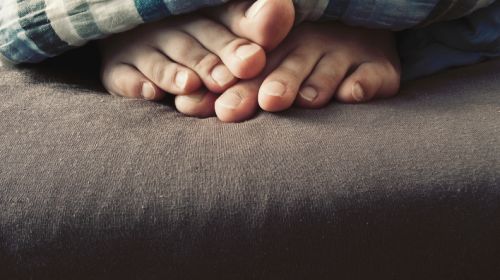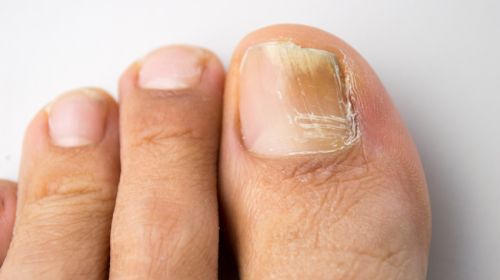Redness, peeling skin and itching: athlete’s foot is unpleasant and highly contagious. If left untreated, the infection can spread to the toenails and also cause nail fungus. Read how you can recognize athlete’s foot and which creams and home remedies can be used to treat it.
- © Getty Images/PhotoAlto/Odilon Dimier
Quick overview: Frequently asked questions and answers
How do I know it’s athlete’s foot? Athlete’s foot usually occurs between the toes. Signs include itching and burning as well as red and cracked skin. As the disease progresses, blisters or whitish skin plates may form.
How do I get rid of athlete’s foot quickly? The fungal infection is treated with creams, gels or sprays that are available without a prescription in pharmacies. They contain active ingredients that kill the fungus.
Can athlete’s foot go away on its own? No, the infection does not usually go away on its own. Without treatment, there is a risk that the fungus will spread further and also affect the toenails.
Article contents at a glance:
What is athlete’s foot?
Athlete’s foot is an infection caused by skin fungi. Technically it is called tinea pedis or foot mycosis.
The causative agents of the skin disease are special filamentous fungi, the dermatophytes (Greek for “skin eaters”). They prefer moist, warm areas of skin and attack the uppermost layers of skin.
Foot mycosis is widespread: around 70 percent of the population will deal with the disease during their lifetime.
Symptoms: These signs indicate athlete’s foot
Typical symptoms of an athlete’s foot infection include itching, redness and flaking skin. Depending on the location and type of skin change, doctors differentiate between three different types:
The interdigital form is the most common form of athlete’s foot. It initially manifests itself as redness and peeling skin between the toes. These can be accompanied by deep, painful cracks. Small blisters may appear on the sides of the toes.
The squamous-hyperkeratotic form first appears on the soles of the feet. From there it gradually spreads to the sides and back of the foot (moccasin mycosis). The skin flakes and is slightly inflamed. Later, the skin becomes severely calloused and cracks. This form mostly affects people with diabetes mellitus.
The vesicular-dyshidrotic form is the rarest form of athlete’s foot. It is accompanied by blisters on the edges and soles of the feet. Since these areas have a thick stratum corneum, the blisters do not burst but dry up. The result is a feeling of tension and itching.
Treat athlete’s foot with creams, sprays and home remedies
When treating athlete’s foot, fungicides are used, i.e. fungi-killing agents (antimycotics) or fungistatics that inhibit fungal growth.
If the fungal disease is not too advanced, it can still be treated externally: various creams, sprays, gels, solutions and powders are available. Most are available in pharmacies without a prescription. The products contain, for example, the active ingredients
- bifonazole,
- clotrimazole and
- Miconazole (azole group of active ingredients).
Ciclopirox or terbinafine are used if the athlete’s foot is very severe or the nails are also affected. The medications require a prescription. Extensive athlete’s foot infections must be treated with tablets or capsules.
As long as it is not yet clear which pathogen is exactly responsible for the infection, so-called broad-spectrum antimycotics are used, which work against several types of fungi at the same time. As soon as the exact pathogen has been identified through a fungal culture, a specific antifungal agent is used.
Do home remedies help against athlete’s foot?
There are numerous home remedies for athlete’s foot circulating. In internet forums, those affected often recommend apple cider vinegar, tea tree oil or baking soda. They should be used as a foot bath or applied directly to the affected skin areas.
However, the effectiveness of these home remedies has not been scientifically proven – and self-experimentation with these remedies usually only delays effective treatment.
Course and prognosis: How long does it take for athlete’s foot to go away?
The duration of athlete’s foot treatment depends on the active ingredient in the preparation. In most cases, the products need to be used for three to six weeks. The active ingredient terbinafine is an exception. It is usually sufficient to use such agents for one week.
The symptoms of an infection can often be quickly alleviated with appropriate therapy. However, those affected should not stop the treatment, but should continue to use it for three to four weeks as directed by their doctor. Since the fungal spores are very stubborn, this can prevent a relapse after stopping the medication.
During treatment, it is also advisable to treat shoes with a disinfectant spray and wear cotton socks. These should be changed daily and cleaned at at least 60 degrees Celsius.
Complications of a fungal infection
If an infection with athlete’s foot is left untreated, it can spread to other areas of the body – the hands, groins and toenails are most commonly affected (nail fungus).
If the skin becomes cracked, bacterial infections can also occur. In addition to bacteria, viruses can also cause serious inflammation. Older people and people with poor blood circulation in their feet are particularly affected, which is often the case with diseases such as diabetes mellitus.
Skin fungi can also be particularly dangerous for people who suffer from an immune deficiency or whose immune system is suppressed, for example as part of chemotherapy.
However, if treated promptly and consistently, an athlete’s foot infection usually heals without complications.
What causes athlete’s foot?
The risk of infection is particularly high where many people walk barefoot. There is a risk in swimming pools, saunas, changing rooms or hotel rooms.
Transmission occurs through direct skin contact or when walking barefoot across various floor surfaces. Skin flakes containing fungal spores remain there and end up on other people’s feet.
However, contact with the pathogens does not necessarily have to lead to an infection: certain conditions must be met for the infectious disease to break out. The skin fungi feel most comfortable in a warm, humid environment, such as that found in closed shoes. Hobby and professional athletes in particular are often affected by tinea pedis.
Risk factors for athlete’s foot infection
In addition to people who are active in sports, people are also at risk
Foot misalignments where the toes are close together can also promote the development of an athlete’s foot infection. These often have smaller skin injuries and cracks, which offer athlete’s foot and bacteria an entry point into the skin. Poor foot care and sweaty feet also promote the disease.
With increasing age, the likelihood of athlete’s foot also increases. But children are by no means immune to athlete’s foot, as they go barefoot a lot and usually like to go to the swimming pool.
Athlete’s foot: diagnosis with spatula and laboratory culture
If typical signs of athlete’s foot occur, we recommend going to a general practitioner or dermatologist. Since these symptoms also occur in other skin diseases, the doctor examines small samples from the skin surface under the microscope. The skin cells are removed with a small spatula and are painless.
In order to determine the type of fungi and the extent of the infection more precisely, a fungal culture is usually created: the growth of the fungus is stimulated on a nutrient medium so that the pathogen can be precisely identified after one to four weeks.
Prevent athlete’s foot: This way the fungus doesn’t stand a chance
To prevent athlete’s foot, it is important to avoid contact with the pathogen and not to provide good conditions for the skin fungus. The following tips reduce the risk of illness or infection:
Wear appropriate shoes: choose well-fitting and breathable footwear and always let them dry well
Wear socks made from natural fibers: Prefer stockings made of breathable materials and change them every day
Observe good foot hygiene: Wash feet thoroughly every day, especially after exercise
Avoid waterlogging: Dry feet and between toes carefully after showering or bathing
Don’t walk barefoot: wear bathing shoes in swimming pools, changing rooms and saunas
Check foot health: Check your feet regularly for abnormalities and changes such as cracks, redness and flaking between the toes
Reduce risk of infection: Avoid towels and shoes belonging to infected family members


